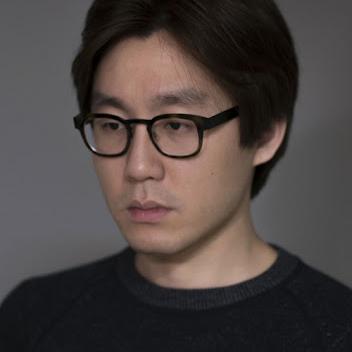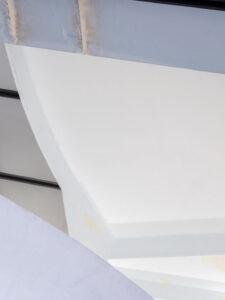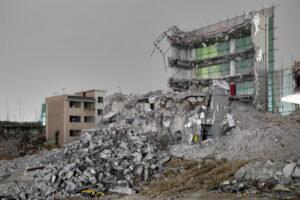






Jung Jihyun graduated from Chung-Ang University’s Department of Photography (2010) and obtained a master’s degree (2016). He later completed his Ph.D. program in the Department of Arts at the same graduate school (2019).
Jung Jihyun works to share and record memories about the city’s architecture through his photos. His artist intervenes formative in the construction site and constructs his art form by temporarily transforming elements or parts of the architecture.
The walls were painted red to express that destructive sites were places of life in the past, or to transform the space by installing variable structures with building materials. What is revealed nakedly in this way is the ‘inside’, neither inside nor outside, of buildings we have never seen before.
- Works for Sale
- Artistic Career
- World of Work
- Activity
Urban Architecture with Photographs
Urban Architecture with Photographs
Solo Exhibitions (Brief)
Jung Jihyun has held eight solo exhibitions held in various spaces such as SongEun Art Space(Seoul, Korea), KT&G Sangsangmadang(Seoul, Korea), SPACEONEWWALL(Seoul, Korea), BMW Photo Space(Busan, Korea) so far.
Group Exhibitions (Brief)
Jung Jihyun has been participated in a wide range of group exhibitions held at Incheon Art Platform(Incheon, Korea), Kimchungup Architecture Museum(Anyang, Korea), Seoul Museum of Art(Seoul, Korea), Korean Culture Center(Warsaw, Poland), Amorepacific Museum of Art(Seoul, Korea) and Gyeonggi Creation Center(Ansan, Korea).
Awards (Selected)
Jung Jihyun received the 14th SAJINBIPYONG Award(Photo Space, Korea). He was selected the final artist of the year of the 6th KT&G SKOPF(KT&G Sangsangmadang, Korea) and nominated for International Photo Award such as Leica Oskar Barnak Award and Prix Pictet.
Collections (Selected)
His works are in collections of various museums such as National Musesum of Modern and Contemporary Art(Gwacheon, Korea), Seoul Museum of Art(Seoul, Korea), Busan Museum of Contemporary Art(Busan, Korea), AmorePacific Museum(Seoul, Korea), The Museum of Photography(Seoul, Korea and GoEun Museum of Photography(Busan, Korea).
Urban Architecture with Photographs
Urban Architecture with Photographs
Originality & Identity
Jung Jihyun is making art by recording and memorizing urban architecture with photographs. The apartment where he has lived, Jamsil Jugong APT, started to redevelop in his twenties. The whole area where his childhood memories had suddenly disappeared.
This experience of losing his memories was a major impression on him that influenced him considerably.
The artist shoots photos of the construction sites of buildings that are deconstructed or constructed. He often encounters these construction sites while walking down the streets, but these are partial realities hidden by the curtain of the construction area.
In his prior works, he had dealt with the city’s history by filming construction sites of apartment buildings being deconstructed or redeveloped. Recently, he has tried to record the newest skyscrapers that make up the large structure of the city and imagine the city’s future.
His photographs incorporate two opposing activities; architectural photography preserves and archives urban architecture, and artistic photography dismantles and reveals hidden things. He intervenes in the form of an object on the construction site and constructs his art form by temporarily transforming parts of the architecture.
Painting walls in red, he marks the deconstructive sites in the past and then changes some of the pieces in his artistic ways. Jung Jihyun exposes the ‘inside’ of the buildings, neither inside nor outside of the buildings.
Jung Jihyun’s photo captures disappearing landscapes and construction sites that constantly change day by day. As the process of construction work is being built at its own pace. Therefore, he could only capture the red concrete power which he had painted before, and it is because the wall exploded in a day. The underlying lesson for the artist is that if the moments are not captured immediately, then the critical art materials disappear. It becomes a motivation for the artist to observe and record with desperation.
The audience constantly realizes the emptiness and limited feeling after appreciating the scenery of breaking down the buildings. The apartments that are someone’s symbol of dream collapse by the new stakeholders and the logic of capitalism.
However, the artist records continuously without any compassion. As it is layered with ceaseless vertical and horizontal structures, the buildings are intersected with different memories and thoughts.
Style & Contents
Jung Jihyun received great attention with his series ‘Demolision Site’ (2013) and ‘Reconstruction Site’ (2015), expressed with red colour by the intervention of the artist. He initially discovers and intervenes in the ‘site’ and observes the shifts of the area through continued experiences for a long time. In this process, the artist becomes a part of the space and temporarily occupies it through the act of painting an entire floor.
For the next step, he goes outside and looks for a suitable area where a frame can be set. The red wall from the outside of the building was soon shattered into particles by the demolition progress.
City buildings are a place where various narratives intersect, but it is hard to read the detailed history of individuals or society. What is outstanding in these dry photos are the images of broken sections, the structure of buildings, and the shapes and textures of architectural elements.
The artist actively invaded the space so that his photos imply the meaning of visual spectacles of the ruins, not just consuming the art materials. The red wall represents traces from the construction work like temporal sounds or the collapse of buildings.
Recently, Jung Jihyun mainly worked on archiving the construction process of new buildings in commission type. He carried out various archive works, such as ‘Construct’ (2017), where he documented the construction of Amore Pacific’s new office building. In ‘Reconstruct’ (2020~2021), he documented the remodeling and restoration of the SamIl Building (the first skyscraper and curtainwall building in Korea) symbolizing the high economic growth in the 1970s, and ‘Structure Studies Topology’ (2019~2021) contains the construction site of the new building SongEun Art Space.
Jung Jihyun records the ever-changing appearance of the building from the groundwork to the completed construction works. He was invited by the core member of the construction field, unlike in the past, when he had to sneak inside the building or get permission.
The construction field allows a more intimate and delicate perspective when he captures the sites with photographs. The artist intervenes in the objects inside the building that create space and illustrates the shifts of the interior materials and functions. Sometimes he builds up various formats and aesthetics within the construction site with installation.
Constancy & Continuity
The photos that the artist films in the building have an automatic historical meaning as cities’ environmental archives. However, Jung Jihyun’s works have a different style from other architectural photos that illustrate objective information or collecting architectural types.
Jung Jihyun’s photographs describe places that have already been blasted and disappeared and, hence, have a unique sense of time and meaning.
His works are accompanied by both historical photographs and artistic activities. The visual enjoyment is also impressive, but it is worth noting that it continues to redefine how photography works. The performance by his attitude, intervening in space can be seen as a type of contemporary art.
Artistic experiments such as abstract spatial drawing attempted by arranging objects on the construction site and tactical contract of various materials also transform the works. It occurs some unanticipated points for the audience. Also, Jung Jihyun places his photos on multiple materials and contexts. He printed the pictures on adhesive vinyl and installed them in outdoor spaces or UV printing on the smooth glass to create a visual and tactile experience.
The critical point why Jung Jihyun is a unique photographer position is that these metaphors and artist expressions are placed on a neutral attitude. Rather than capturing objects that evoke emotional nostalgia, the artist concentrates on visual and structural forms of architecture. Jung Jihyun’s cynical and refined perspective continued to make a historical change inside and outside the city. This has the meaning of archiving the public memories inside the buildings.
Urban Architecture with Photographs
Urban Architecture with Photographs
Urban Architecture with Photographs
Urban Architecture with Photographs
- Works for Sale
- Artistic Career
- World of Work
- Activity
Urban Architecture with Photographs
Urban Architecture with Photographs
Solo Exhibitions (Brief)
Jung Jihyun has held eight solo exhibitions held in various spaces such as SongEun Art Space(Seoul, Korea), KT&G Sangsangmadang(Seoul, Korea), SPACEONEWWALL(Seoul, Korea), BMW Photo Space(Busan, Korea) so far.
Group Exhibitions (Brief)
Jung Jihyun has been participated in a wide range of group exhibitions held at Incheon Art Platform(Incheon, Korea), Kimchungup Architecture Museum(Anyang, Korea), Seoul Museum of Art(Seoul, Korea), Korean Culture Center(Warsaw, Poland), Amorepacific Museum of Art(Seoul, Korea) and Gyeonggi Creation Center(Ansan, Korea).
Awards (Selected)
Jung Jihyun received the 14th SAJINBIPYONG Award(Photo Space, Korea). He was selected the final artist of the year of the 6th KT&G SKOPF(KT&G Sangsangmadang, Korea) and nominated for International Photo Award such as Leica Oskar Barnak Award and Prix Pictet.
Collections (Selected)
His works are in collections of various museums such as National Musesum of Modern and Contemporary Art(Gwacheon, Korea), Seoul Museum of Art(Seoul, Korea), Busan Museum of Contemporary Art(Busan, Korea), AmorePacific Museum(Seoul, Korea), The Museum of Photography(Seoul, Korea and GoEun Museum of Photography(Busan, Korea).
Urban Architecture with Photographs
Urban Architecture with Photographs
Originality & Identity
Jung Jihyun is making art by recording and memorizing urban architecture with photographs. The apartment where he has lived, Jamsil Jugong APT, started to redevelop in his twenties. The whole area where his childhood memories had suddenly disappeared.
This experience of losing his memories was a major impression on him that influenced him considerably.
The artist shoots photos of the construction sites of buildings that are deconstructed or constructed. He often encounters these construction sites while walking down the streets, but these are partial realities hidden by the curtain of the construction area.
In his prior works, he had dealt with the city’s history by filming construction sites of apartment buildings being deconstructed or redeveloped. Recently, he has tried to record the newest skyscrapers that make up the large structure of the city and imagine the city’s future.
His photographs incorporate two opposing activities; architectural photography preserves and archives urban architecture, and artistic photography dismantles and reveals hidden things. He intervenes in the form of an object on the construction site and constructs his art form by temporarily transforming parts of the architecture.
Painting walls in red, he marks the deconstructive sites in the past and then changes some of the pieces in his artistic ways. Jung Jihyun exposes the ‘inside’ of the buildings, neither inside nor outside of the buildings.
Jung Jihyun’s photo captures disappearing landscapes and construction sites that constantly change day by day. As the process of construction work is being built at its own pace. Therefore, he could only capture the red concrete power which he had painted before, and it is because the wall exploded in a day. The underlying lesson for the artist is that if the moments are not captured immediately, then the critical art materials disappear. It becomes a motivation for the artist to observe and record with desperation.
The audience constantly realizes the emptiness and limited feeling after appreciating the scenery of breaking down the buildings. The apartments that are someone’s symbol of dream collapse by the new stakeholders and the logic of capitalism.
However, the artist records continuously without any compassion. As it is layered with ceaseless vertical and horizontal structures, the buildings are intersected with different memories and thoughts.
Style & Contents
Jung Jihyun received great attention with his series ‘Demolision Site’ (2013) and ‘Reconstruction Site’ (2015), expressed with red colour by the intervention of the artist. He initially discovers and intervenes in the ‘site’ and observes the shifts of the area through continued experiences for a long time. In this process, the artist becomes a part of the space and temporarily occupies it through the act of painting an entire floor.
For the next step, he goes outside and looks for a suitable area where a frame can be set. The red wall from the outside of the building was soon shattered into particles by the demolition progress.
City buildings are a place where various narratives intersect, but it is hard to read the detailed history of individuals or society. What is outstanding in these dry photos are the images of broken sections, the structure of buildings, and the shapes and textures of architectural elements.
The artist actively invaded the space so that his photos imply the meaning of visual spectacles of the ruins, not just consuming the art materials. The red wall represents traces from the construction work like temporal sounds or the collapse of buildings.
Recently, Jung Jihyun mainly worked on archiving the construction process of new buildings in commission type. He carried out various archive works, such as ‘Construct’ (2017), where he documented the construction of Amore Pacific’s new office building. In ‘Reconstruct’ (2020~2021), he documented the remodeling and restoration of the SamIl Building (the first skyscraper and curtainwall building in Korea) symbolizing the high economic growth in the 1970s, and ‘Structure Studies Topology’ (2019~2021) contains the construction site of the new building SongEun Art Space.
Jung Jihyun records the ever-changing appearance of the building from the groundwork to the completed construction works. He was invited by the core member of the construction field, unlike in the past, when he had to sneak inside the building or get permission.
The construction field allows a more intimate and delicate perspective when he captures the sites with photographs. The artist intervenes in the objects inside the building that create space and illustrates the shifts of the interior materials and functions. Sometimes he builds up various formats and aesthetics within the construction site with installation.
Constancy & Continuity
The photos that the artist films in the building have an automatic historical meaning as cities’ environmental archives. However, Jung Jihyun’s works have a different style from other architectural photos that illustrate objective information or collecting architectural types.
Jung Jihyun’s photographs describe places that have already been blasted and disappeared and, hence, have a unique sense of time and meaning.
His works are accompanied by both historical photographs and artistic activities. The visual enjoyment is also impressive, but it is worth noting that it continues to redefine how photography works. The performance by his attitude, intervening in space can be seen as a type of contemporary art.
Artistic experiments such as abstract spatial drawing attempted by arranging objects on the construction site and tactical contract of various materials also transform the works. It occurs some unanticipated points for the audience. Also, Jung Jihyun places his photos on multiple materials and contexts. He printed the pictures on adhesive vinyl and installed them in outdoor spaces or UV printing on the smooth glass to create a visual and tactile experience.
The critical point why Jung Jihyun is a unique photographer position is that these metaphors and artist expressions are placed on a neutral attitude. Rather than capturing objects that evoke emotional nostalgia, the artist concentrates on visual and structural forms of architecture. Jung Jihyun’s cynical and refined perspective continued to make a historical change inside and outside the city. This has the meaning of archiving the public memories inside the buildings.





